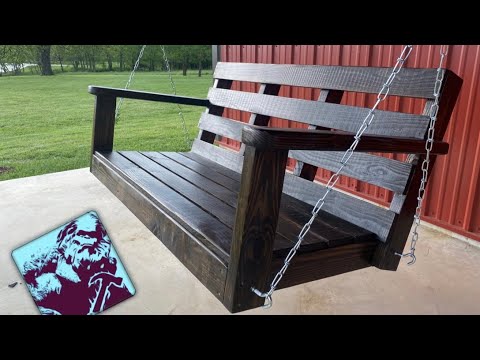schommelbank
How to Build a SIMPLE Porch Swing (basic tools!)
Are you looking to enhance your outdoor space with a charming addition that will provide hours of relaxation? Building a porch swing is a fantastic project that will not only add aesthetic appeal to your porch but also provide a comfortable spot to unwind and enjoy the fresh air. In this article, we will guide you through the process of building a simple porch swing using basic tools.
Table of Contents
- Materials and Tools
- Choosing the Right Wood
- Designing Your Porch Swing
- Measuring and Cutting
- Assembling the Swing
- Finishing Touches
- Questions and Answers
Materials and Tools
Before diving into the construction process, it’s essential to gather the necessary materials and tools. Here’s a list of what you’ll need:
- Wood boards (preferably pressure-treated)
- Screws
- Drill
- Saw
- Tape measure
- Sandpaper
- Paint or stain
- Paintbrush
It’s important to choose high-quality materials to ensure the durability and longevity of your porch swing. Pressure-treated wood is an excellent choice as it is resistant to rot and decay, making it ideal for outdoor use.
Choosing the Right Wood
When selecting the wood for your porch swing, consider using a hardwood like oak or cedar. These woods are known for their durability and resistance to weathering. Alternatively, if you prefer a more budget-friendly option, pine is a great choice.
Ensure that the wood is smooth and free from any cracks or knots that may weaken the swing. It’s also advisable to use treated wood or apply a protective finish to shield it from the elements.
Designing Your Porch Swing
Before you start cutting the wood, it’s essential to design your porch swing. Decide on the size, shape, and style that best suits your porch and personal preferences. Consider whether you want a traditional straight-backed swing or a more contemporary design with a curved backrest.
Sketch out your design on paper or use a design software to visualize the final product. This step will help you determine the dimensions and quantities of wood required.
Measuring and Cutting
Once you have your design in place, it’s time to measure and cut the wood. Use a tape measure to determine the length and width of each piece according to your design specifications.
Take extra care to ensure accurate measurements, as any discrepancies can affect the stability and overall appearance of the swing. Remember the old saying, “Measure twice, cut once.”
When cutting the wood, use a saw appropriate for the type of wood you’ve chosen. A miter saw or circular saw can make precise cuts, but a hand saw can also do the job effectively.
Assembling the Swing
With all your wood pieces cut to size, it’s time to assemble the porch swing. Start by attaching the seat and backrest boards to the side supports using screws and a drill. Make sure to align the boards properly and secure them tightly to ensure stability.
Next, attach the armrests and any additional decorative elements you desire. Remember to pre-drill holes to prevent the wood from splitting. Once all the pieces are securely fastened, give the swing a gentle shake to ensure it is sturdy and well-constructed.
Finishing Touches
To protect your porch swing and enhance its appearance, consider applying a coat of paint or stain. Choose a color that complements your porch and outdoor decor. Apply the finish evenly with a paintbrush, following the manufacturer’s instructions.
Allow the paint or stain to dry completely before installing the swing on your porch. This step will not only add beauty to your swing but also provide protection against moisture and UV rays.
Questions and Answers
How much weight can a porch swing support?
The weight capacity of a porch swing depends on the materials and construction. Generally, a well-built swing can support between 500 to 1000 pounds. However, it’s always best to refer to the manufacturer’s guidelines for specific weight limits.
Can I hang the porch swing from a tree?
While it may be tempting to hang your porch swing from a tree, it’s not recommended. The branches may not be strong enough to support the weight of the swing and could pose a safety risk. It’s best to install the swing on a sturdy porch beam or frame.
How can I maintain my porch swing?
To keep your porch swing in optimal condition, regularly inspect it for any signs of wear or damage. Clean it with mild soap and water, and apply a fresh coat of paint or stain when necessary. During winter or inclement weather, consider covering or storing the swing to protect it from the elements.
Conclusion
Building a simple porch swing can be a rewarding and enjoyable project that adds both beauty and functionality to your porch. By following the steps outlined in this article, you can create a comfortable and inviting space where you can relax and unwind. Remember to choose quality materials, measure accurately, and pay attention to the construction details to ensure a sturdy and durable swing. With your new porch swing, you’ll have the perfect spot to enjoy lazy summer afternoons or cozy evenings with loved ones.
Easy Porch Swing Build! This video will walk you through step by step on how to build a porch swing. This porch swing is really …





